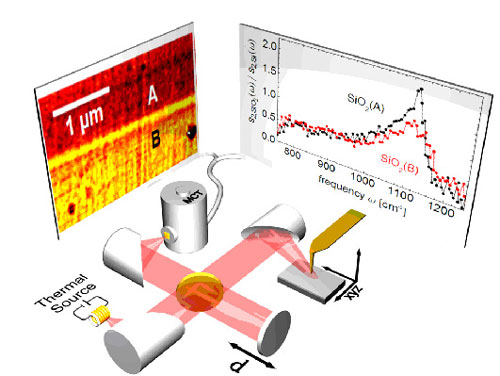| May 09, 2011 |
Nano-FTIR - nanoscale infrared spectroscopy with a thermal source
|
|
(Nanowerk News) Researchers from the Basque nanoscience research center CIC nanoGUNE and Neaspec GmbH (Germany) have developed an instrument that allows for recording infrared spectra with a thermal source at a resolution that is 100 times better than in conventional infrared spectroscopy. In future, the technique could be applied for analyzing the local chemical composition and structure of nanoscale materials in polymer composites, semiconductor devices, minerals or biological tissue. The work is published in Nature Materials ("Infrared-spectroscopic nanoimaging with a thermal source").
|
 |
| Infrared nanospectroscopy with a thermal source. The tip is illuminated with the broadband infrared radiation from of a thermal source and the backscattered light is analyzed with a Fourier spectrometer, yielding local infrared spectra with a spatial resolution better than 100 nm. The displayed graph shows infrared spectra of differently processed oxides in an industrial semiconductor device. (Copyright F. Huth, CIC nanoGUNE)
|
|
The absorption of infrared radiation is characteristic for the chemical composition and structure of materials. For this reason, an infrared spectrum can be considered as a material's "fingerprint". Infrared spectroscopy has thus become an important tool for characterizing and identifying materials and is widely applied in different sciences and technologies including materials sciences and biomedical diagnostics. However, with conventional optical instruments, such as FTIR (Fourier Transform Infrared) infrared spectrometers, the light cannot be focused to spot sizes below several micrometers. This fundamental limitation prevents infrared-spectroscopic mapping of single nanoparticles, molecules or modern semiconductor devices.
|
|
Researchers at nanoGUNE and Neaspec have now developed an infrared spectrometer that allows for nanoscale imaging with thermal radiation. The setup –in short nano-FTIR (see Figure) - is based on a scattering-type near-field microscope (NeaSNOM) that uses a sharp metallic tip to scan the topography of a sample surface. While scanning the surface, the tip is illuminated with the infrared light from a thermal source. Acting like an antenna, the tip converts the incident light into a nanoscale infrared spot (nanofocus) at the tip apex. By analyzing the scattered infrared light with a specially designed FTIR spectrometer, the researchers were able to record infrared spectra from ultra-small sample volumes.
|
|
In their experiments, the researchers managed to record infrared images of a semiconductor device from Infineon Technologies AG (Munich). "We achieved a spatial resolution better than 100 nm. This directly shows that thermal radiation can be focused to a spot size that is hundred times smaller than in conventional infrared spectroscopy", says FlorianHuth, who performed the experiments. The researcher demonstrated that nano-FTIR can be applied for recognizing differently processed silicon oxides or to measure the local electron density within complex industrial electronic devices. "Our technique allows for recording spectra in the near- to far-infrared spectral range. This is an essential feature for analyzing the chemical composition of unknown nanomaterials", explains Rainer Hillenbrand, leader of the Nanooptics group at nanoGUNE.
|
|
Nano-FTIR has interesting application potential in widely different sciences and technologies, ranging from semiconductor industry to nanogeochemistry and astrophysics. "Based on vibrational fingerprint spectroscopy, it could be applied for nanoscale mapping of chemical composition and structural properties of organic and inorganic nano-systems, including organic semiconductors, solar cells, nanowires, ceramics and minerals", adds Florian Huth.
|

